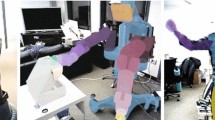Abstract
A new device for movement detection in joints is designed using the moiré technique. Archimedean spiral grids are used. A space displacement may be evaluated in two planes by vectors of known magnitudes and directions. An extremely simple design is proposed to provide stability for the system being installedin situ over long periods of time.
Similar content being viewed by others
References
Košťák, B., “Zarízení ke zjîsîování a měření relativních pohybů nebo posunů těles,” Czechoslovak Patent Application No. 4602-67.
Pirard, A., “Consideration sur la méthode du moiré en photoélasticité,”Revue Universelle des Mines,16,9 Série (1960).
Oster, G., and Nishijima, Y., “Moiré Patterns,” Sci. Amer. (May 1963).
Košťák, B., “General Interpretation of Moiré Patterns in Strain Analysis,” Jnl. Strain Anal. (April 1968).
Košťák, B., and Popp, K., “Moiré Strain Gauges,” Strain,2 (1966).
Author information
Authors and Affiliations
Rights and permissions
About this article
Cite this article
Košťák, B. A new device for in-situ movement detection and measurement. Experimental Mechanics 9, 374–379 (1969). https://doi.org/10.1007/BF02327715
Issue Date:
DOI: https://doi.org/10.1007/BF02327715




